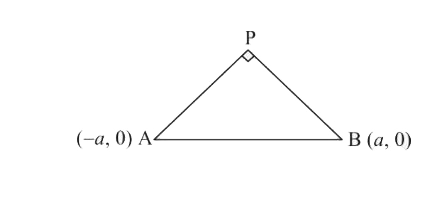are two given points. A point M is moving in such a way that the angle B in the triangle AMB remains twice as large as the angle A. Show that the locus of the point M is a hyperbola. Fnd the eccentricity of the hyperbola.
To solve the problem, we need to show that the locus of point M, which moves such that the angle B in triangle AMB is twice the angle A, forms a hyperbola. We will also find the eccentricity of the hyperbola.
1. Identify the Points:
Let A = (-1, 0) and B = (2, 0). Let M be a point (h, k) in the coordinate plane.
2. Determine the Slopes:
The slope of line AM (from A to M) is given by:
m1=k−0h+1=kh+1
The slope of line BM (from B to M) is given by:
m2=k−0h−2=kh−2
3. Relate the Angles:
We know that angle B is twice angle A. Using the tangent of angles, we can express this as:
tan(2θ)=2tan(θ)1−tan2(θ)
Here, we set tan(θ)=m1 and tan(2θ)=m2.
4. Substitute the Slopes:
Substituting the slopes into the tangent relationship gives:
kh−2=2(kh+1)1−(kh+1)2
5. Cross-Multiply:
Cross-multiplying leads to:
k(h+1)2=2k(h−2)(1−k2(h+1)2)
6. Simplify the Equation:
Expanding and simplifying the equation will yield:
k(h+1)2=2k(h−2)−2k3(h−2)(h+1)2
Rearranging gives:
k(h+1)2+2k3(h−2)(h+1)2=2k(h−2)
7. Rearranging Terms:
After some algebraic manipulation, we arrive at:
3h2+k2=3
8. Divide by 3:
Dividing the entire equation by 3 gives:
h21−k23=1
This is the standard form of a hyperbola.
Finding the Eccentricity:
The standard form of a hyperbola is given by:
h2a2−k2b2=1
where a2=1 and b2=3.
The eccentricity e of a hyperbola is given by:
e=√1+b2a2=√1+31=√4=2
Final Result:
The locus of point M is a hyperbola, and the eccentricity of the hyperbola is e=2.
Let A = (-1, 0) and B = (2, 0). Let M be a point (h, k) in the coordinate plane.
The slope of line AM (from A to M) is given by:
m1=k−0h+1=kh+1
The slope of line BM (from B to M) is given by:
m2=k−0h−2=kh−2
We know that angle B is twice angle A. Using the tangent of angles, we can express this as:
tan(2θ)=2tan(θ)1−tan2(θ)
Here, we set tan(θ)=m1 and tan(2θ)=m2.
Substituting the slopes into the tangent relationship gives:
kh−2=2(kh+1)1−(kh+1)2
Cross-multiplying leads to:
k(h+1)2=2k(h−2)(1−k2(h+1)2)
Expanding and simplifying the equation will yield:
k(h+1)2=2k(h−2)−2k3(h−2)(h+1)2
Rearranging gives:
k(h+1)2+2k3(h−2)(h+1)2=2k(h−2)
After some algebraic manipulation, we arrive at:
3h2+k2=3
Dividing the entire equation by 3 gives:
h21−k23=1
This is the standard form of a hyperbola.
h2a2−k2b2=1
where a2=1 and b2=3.
e=√1+b2a2=√1+31=√4=2
The locus of point M is a hyperbola, and the eccentricity of the hyperbola is e=2.
Topper's Solved these Questions
Similar Questions
A(2, 0) and B(4, 0) are two given points. A point P moves so that PA2+PB2=10. Find the locus of P.
View SolutionA(2, 0) and B(4, 0) are two given points. A point P moves so that P A 2 + P B 2 = 10 . Find the locus of P.
View SolutionA and B are two fixed points. The locus of a point P such that ∠APB is a right angle, is:

View SolutionA (a,0) , B (-a,0) are two points . If a point P moves such that ∠PAB−∠PBA=π/2 then find the locus of P.
View SolutionThe angle between a pair of tangents drawn from a point P to the hyperbola y2=4ax is 45∘. Show that the locus of the point P is hyperbola.
View SolutionA(a,0) , B(-a,0) are two point . If a point P moves such that ∠PAB−∠PBA=2α then find the locus of P .
View SolutionGiven two points A and B. If area of triangle ABC is constant then locus of point C in space is
View SolutionIf m is a variable, then prove that the locus of the point of intersection of the lines x3−y2=mandx3+y2=1m is a hyperbola.
View SolutionGiven the base of a triangle and the ratio of the tangent of half the base angles .Show that the vertex moves on a hyperbola whose foci are the extremities of a diameter
View SolutionIf AOBandCOD are two straight lines which bisect one another at right angles, show that the locus of a points P which moves so that PAxPB=PCxPD is a hyperbola. Find its eccentricity.
View Solution
